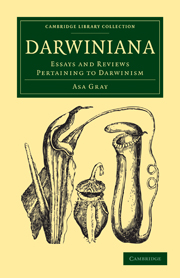Book contents
- Frontmatter
- PREFACE
- Contents
- ARTICLE I THE ORIGIN OF SPECIES BY MEANS OF NATURAL SELECTION
- ARTICLE II DESIGN versus NECESSITY—A DISCUSSION
- ARTICLE III NATURAL SELECTION NOT INCONSISTENT WITH NATURAL THEOLOGY
- ARTICLE IV SPECIES AS TO VARIATION, GEOGRAPHICAL DISTRIBUTION, AND SUCCESSION
- ARTICLE V SEQUOIA AND ITS HISTORY: THE RELATIONS OF NORTH AMERICAN TO NORTH-EASTERN ASIAN AND TO TERTIARY VEGETATION
- ARTICLE VI THE ATTITUDE OF WORKING NATURALISTS TOWARD DARWINISM
- ARTICLE VII EVOLUTION AND THEOLOGY
- ARTICLE VIII “WHAT IS DARWINISM?”
- ARTICLE IX CHARLES DARWIN: SKETCH ACCOMPANYING A PORTRAIT IN “NATURE”
- ARTICLE X INSECTIVOROUS PLANTS
- ARTICLE XI INSECTIVOROUS AND CLIMBING PLANTS
- ARTICLE XII DURATION AND ORIGINATION OF RACE AND SPECIES
- ARTICLE XIII EVOLUTIONARY TELEOLOGY
- INDEX
ARTICLE XIII - EVOLUTIONARY TELEOLOGY
Published online by Cambridge University Press: 05 October 2010
- Frontmatter
- PREFACE
- Contents
- ARTICLE I THE ORIGIN OF SPECIES BY MEANS OF NATURAL SELECTION
- ARTICLE II DESIGN versus NECESSITY—A DISCUSSION
- ARTICLE III NATURAL SELECTION NOT INCONSISTENT WITH NATURAL THEOLOGY
- ARTICLE IV SPECIES AS TO VARIATION, GEOGRAPHICAL DISTRIBUTION, AND SUCCESSION
- ARTICLE V SEQUOIA AND ITS HISTORY: THE RELATIONS OF NORTH AMERICAN TO NORTH-EASTERN ASIAN AND TO TERTIARY VEGETATION
- ARTICLE VI THE ATTITUDE OF WORKING NATURALISTS TOWARD DARWINISM
- ARTICLE VII EVOLUTION AND THEOLOGY
- ARTICLE VIII “WHAT IS DARWINISM?”
- ARTICLE IX CHARLES DARWIN: SKETCH ACCOMPANYING A PORTRAIT IN “NATURE”
- ARTICLE X INSECTIVOROUS PLANTS
- ARTICLE XI INSECTIVOROUS AND CLIMBING PLANTS
- ARTICLE XII DURATION AND ORIGINATION OF RACE AND SPECIES
- ARTICLE XIII EVOLUTIONARY TELEOLOGY
- INDEX
Summary
When Cuvier spoke of the “combination of organs in such order that they may be in consistence with the part which the animal has to play in Nature,” his opponent, Geoffroy St.-Hilaire, rejoined, “I know nothing of animals which have to play a part in Nature.” The discussion was a notable one in its day. From that time to this, the reaction of morphology against “final causes” has not rarely gone to the extent of denying the need and the propriety of assuming ends in the study of animal and vegetable organizations. Especially in our own day, when it became apparent that the actual use of an organ might not be the fundamental reason of its existence—that one and the same organ, morphologically considered, was modified in different cases to the most diverse uses, while intrinsically different organs subserved identical functions, and consequently that use was a fallacious and homology the surer guide to correct classification—it was not surprising that teleological ideas nearly disappeared from natural history. Probably it is still generally thought that the school of Cuvier and that of St.-Hilaire have neither common ground nor capability of reconcilement.
In a review of Darwin's volume on the “Fertilization of Orchids” (too technical and too detailed for reproduction here), and later in a brief sketch of the character of his scientific work (art. x., p. 284), we expressed our sense of the great gain to science from his having brought back teleology to natural history.
- Type
- Chapter
- Information
- DarwinianaEssays and Reviews Pertaining to Darwinism, pp. 356 - 390Publisher: Cambridge University PressPrint publication year: 2009First published in: 1876



